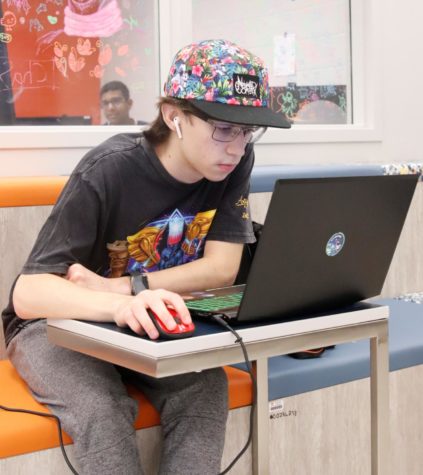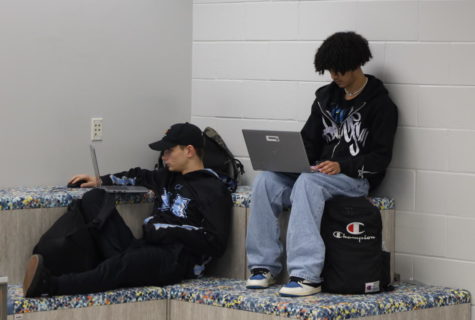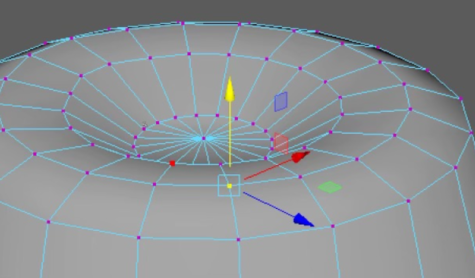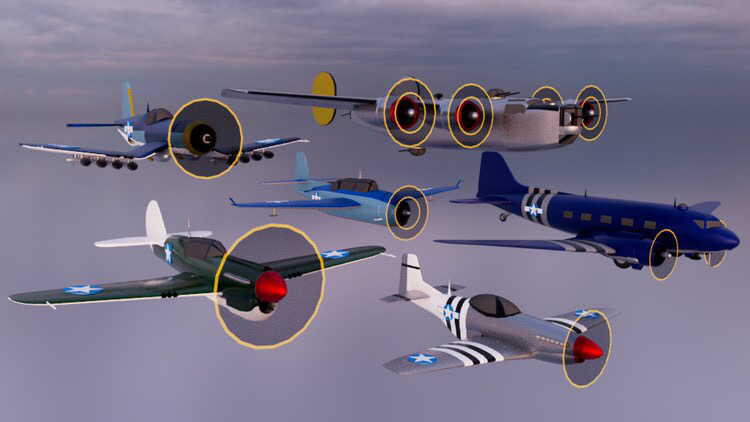Your donation will support the student journalists of Hagerty High School. We are an ad-free publication, and your contribution helps us publish six issues of the BluePrint and cover our annual website hosting costs. Thank you so much!
With emphasis
Modeling and Simulation has been Hagerty's program of emphasis. What type of projects are students assigned? What is the environment like?
A class designated to create games with block coding, geometric vertices and integer variables may seem stressful and demanding. In reality, upper-level Modeling and Simulation students sit in a backroom with music or even shows running while they work. Allowed to go at their own pace, students experiment and play around with modeling and programming engines while creating their video game or simulation.
Modeling and Simulation is a four-year program divided into four levels: Foundation, Design, Application and Prototype and Innovation. Students use various platforms to complete projects ranging from animating characters, modeling their own buildings, using Photoshop to edit their designs and video game creation on one of several engines.
The two most commonly used engines are Maya and Unreal. Maya is specific for the artistic creation of a video game, while Unreal is mainly used for programming. Combining both Maya and Unreal, projects become playable simulations and games that preserve details of the design.

“You get to choose your path whether you want to be a modeler, graphic designer, or programmer. I used to work with Maya the most since I focused more on 3D modeling and designing, but as the year continued, my focus shifted to programming and I began to use Unreal instead,” senior Lila Ormsby said.
Ormsby has previously created an endlessly run game named Panda-monium. She has also modeled characters and sceneries from references.
Foundation, the first year of the program, is an introduction to Maya. Students start out with the basics, learning the tools available in the engine, basic 3D modeling, design and programming. Students will also start working in Photoshop and learning how to design video game characters and structures.
“The first two years of the Mod and Sim program are crucial. They spend time learning a lot of fundamentals about Maya, which allows [students] to succeed on the test,” Mod and Sim teacher Steven Martinez said.
The second year, Design, is heavily focused on the creative aspects of video games.
“I’ve always wanted to try design, I thought it was really interesting and have especially liked this year because we focus a lot on creativity,” sophomore Chris Sanchez said. “As of now, we are working on designing a character that we will eventually sculpt with clay. That way, we are able to get an understanding of dimensions and anatomy before modeling it.”
The third year and fourth year, Application and Prototype and Innovation, are the years students typically find their own pacing, generally participating in long-term group projects. Students get in depth practice using Maya, Unreal and Photoshop. Simultaneously, they develop their programming, modeling and design skills while building capstone projects and a portfolio.

For senior Emma Lundquist’s group of fourth-year students, their goal is to create a weather simulator that will help practice predicting weather accurately using real life meteorology skills.
To start their project, senior Tyler Hancock had to create a folder filled with their new contents including their interface widgets (2D visuals that are activated by sensors). All of this was organized with a system inside Unreal called Blueprint.
“The process is a bit tedious. We have to make sure the coding allows us to see each function like a locator to see the position of the player and prevent sensors from going off from where it is not supposed to,” Hancock said. “There’s a lot of trial and error, but because of our easy deadlines, it’s not too stressful.”
Lundquist’s group consists of five seniors including herself, 3D Modelers Hancock and Megan Dathe, and programmers Westin Mathies and Noah Urbina. To work more efficiently, the group divides tasks among themselves and collaborates with one another for the final vision. However, the project did not come without difficulties. They are having a few problems with the vertices of the watchtower. Vertices tend to take up memory, so the less there are, the smoother the program will run.
“It’s relatively hard to minimize the amount of vertices, you really have to get creative because you don’t really want your game to be slowed down and keep the intricacy of the structure,” Dathe said.

Meanwhile, Hancock has been working on object textures and coloring, and Lundquist has sculpted characters and structures. Mathies has focused on adding widgets to their game, while Urbina sets up the weather instruments and sensors.
“We all play a different role in creating this simulation. Tyler wrote the programming for the widget functions and Megan worked on the small details that ensure a smooth game,” Mathies said. “We basically came together to create something that otherwise could take us ten times longer to accomplish.”
Ormsby’s group, consisting of Avis Shaw, Lilia Wilken-Yoder and Jillian Ricks, decided on a restaurant simulation with a woodland theme. Ormsby and Shaw initially headed the group until Wilken-Yoder joined as a graphic designer and Ricks came in to do environment modeling.
“A big challenge in making the simulation was coordinating team members’ work. We encountered issues with inconsistency. Everyone is always adding something new so it can get difficult to retain a cohesive design,” Ormsby said. “Not to mention all the troubleshooting that comes with making the simulation. Working with programs such as Maya and Unreal involve learning through countless mistakes and obstacles.”
As the lead programmer, Shaw deals with the majority of these issues. They have had little previous knowledge, but learned how to add functions to the simulation using online tutorials, along with much trial and error.
“We have a really talented team behind the project, so no challenge seems too difficult to overcome.Everyone has been essential to the process of making this,” Ormsby said.
Shaw makes the simulation functional; Ormsby makes character models with animations; Wilken-Yoder designs two dimensional graphics; Jillian designs, creates, and adds textures to the environment of the simulation.
The program helps advance careers such as architecture, engineering, economics, meteorology and bioscience. Currently, the program is working with higher education partners including University of Central Florida and Seminole State College.
“There was a need found for Modeling and Simulation professionals in the area of Central Florida,” Martinez said. “Hagerty is within 15 minutes from the area so we were chosen to pilot the program to help meet this need. Providing real world skills and an industry certification makes this an enhanced program.”
The program started in 2011 with 30 students, but now has grown to more than 260 students and two teachers. Reports stated that the technology field for Mod and Sim increased 63%, with over 55,000 job openings throughout Florida. With this rise in demand and the increase of resources for the class, the program decided to take students from other schools and transfer them to Hagerty.
Students zoned out of Hagerty can also apply to the class due to the career and education specialization. They will attend Hagerty full time in order to participate in the program.
“I was originally zoned for Oviedo High school but transferred to Hagerty after finding out about the Modeling and Simulation,” sophomore Jada McGriffin said. “The class so far has allowed me to be creative while designing the video game’s components like the characters. It is a bit difficult but it gives me new challenges that keep the class interesting and fun.”

